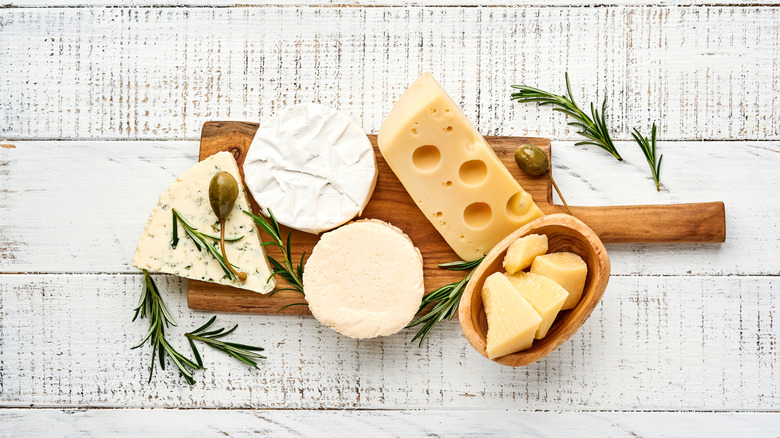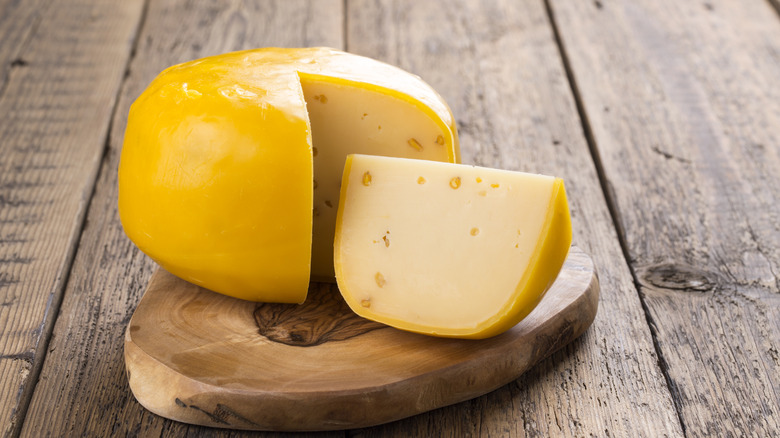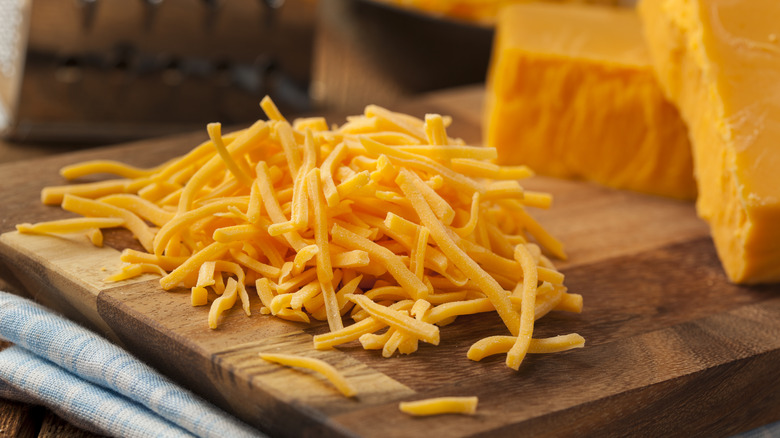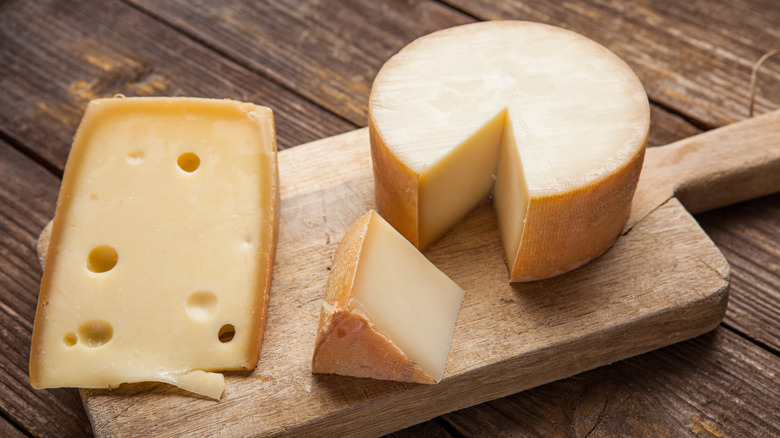Gouda Vs. Cheddar: What's The Difference?
We know cheese has been a part of our diets for a good long while — so much so that the Greeks have a god of cheese, Aristaios, a mythological shepherd, beekeeper, and hunter (via Theoi). The National Historic Cheesemaking Center says that the true origin is so ancient that it's hard to pinpoint a specific place or year that cheese was first created. It's safe to say, though, that cheese-making is intrinsically tied to the domestication of animals, which occurred somewhere around 8,000 to 10,000 years ago. Cheesemaking began with the introduction of rennet to milk, which was then curdled and salted. It could have been a pure accident or an outcome of some experiment. Either way, cheesemaking was born and the world never looked back.
Today, Wisconsin Cheese claims that there are an average of 1,800 different kinds of cheese differentiated by age, milk type, producer, flavor, etc. According to Chef Spencil, the largest producers of cheese in the world are the United States, Germany, France, and Italy, but when it comes to producers per capita Denmark, New Zealand, and Ireland are the world's leaders in 2021. Cheese is a deliciously complex food group with many varieties comparable in look and flavor, like gouda and cheddar. But though these two kinds of cheese seem alike, they have some distinct differences that set them apart.
What is Gouda cheese?
Gouda is really good! Seriously, if you love cheese that has a hint of sweetness with creamy and nutty characteristics, this slice of diary is meant for you. This yellow-hued cheese originated in Europe and — depending on its age — can be soft or hard in texture. The cheese got its name during the Middle Ages (1400–1500 CE) from a southern Holland town that had the sole rights to weigh and sell the cheese (via Cheese Professor). Despite its origin in Holland, this cheese can now be made anywhere in the world. Tridge lists the world's top exporter of gouda as the Netherlands in 2021 and the top importer as Germany.
Castello Cheese explains that gouda is made by mixing fresh cow milk, natural bacteria, and rennet (enzymes necessary for cheese production). The curd made from this mixture is then weighted down and brined and eventually coated with wax for aging which can be a multi-month process that can sometimes take over a year! According to the U.S. Department of Agriculture, one ounce of gouda contains 7 grams of protein. This makes it a solid source of protein, along with the equally delicious cheese variety: cheddar.
What is cheddar cheese?
Cheddar is a cheese-board classic. You'll easily find it shredded, sliced, or in large bulk blocks at your local grocery store or deli. Believe it or not, cheddar with its bright orange looks, buttery texture, and sharp nutty taste is older than every supermarket chain that it's sold in today. Cheese Culture Magazine reports that cheddar has been around since the 12th century in England. Like gouda, cheddar was named after a town well known for its production: Cheddar Village. The small town used natural caves to store milk before refrigeration. It is believed that at some point, someone left some milk in the cave to age into the first known cheddar cheese. The English were huge fans of the stuff, and many a king fell in love with its unique flavor.
According to Food52, cheddar cheese is made from cow milk like gouda is and with age, becomes crumbly in texture. Cheddar is not a protected namesake, meaning that anyone can make cheddar — anywhere in the world — if they are so inclined. Cheddar is made by cutting the cheese curds and stacking them, and then milling them into what we know as "squeaky cheese." But what makes cheddar so unique is the layering process that gives aged cheddar its texture.
How they compare
So, at this point, you might be wondering to yourself what makes gouda and cheddar so different? They both are orange-yellow in color, nutty in flavor, and made from cow's milk. But Masterclass does point out a few key differences between dairy products. For one, cheddar is more pungent and harder in texture than the softer semi-hard gouda. Additionally, if you've shopped for these cheeses before you've probably noticed that gouda comes with a wax rind, whereas cheddar does not. Additionally, gouda has a higher fat content than cheddar.
Recipe Tips suggests using cheddar cheese sliced on sandwiches, served in pieces on a charcuterie board, on pie (yes, apple pie with a slice of cheddar is a real thing), or melting it into macaroni and cheese. Jake's Gouda Cheese says that gouda is also a delicious addition to mac and cheese, and is an ionic melting cheese for soups, potato dishes, grilled cheese, and the classic fondue. Gouda is also paired well with fruits such as apples, peaches, pears, apricots, and cherries. It pairs well with wines like dry riesling, chardonnay, grenache, and Beaujolais.



